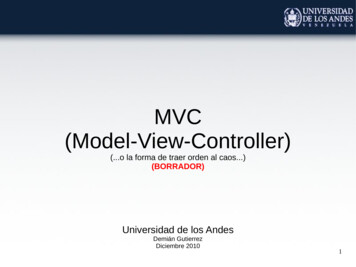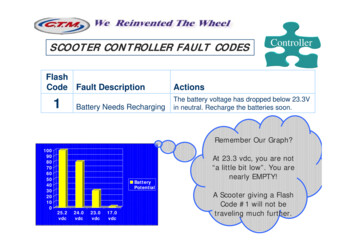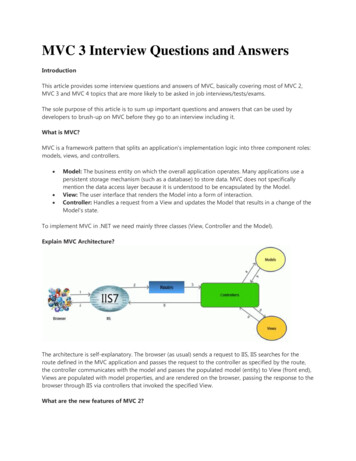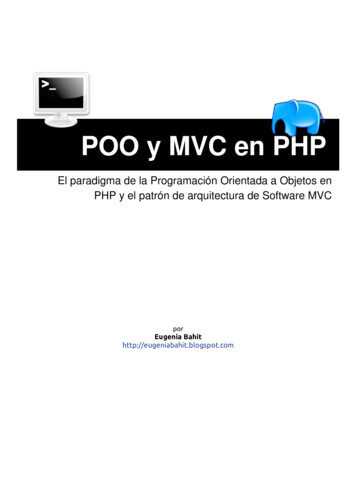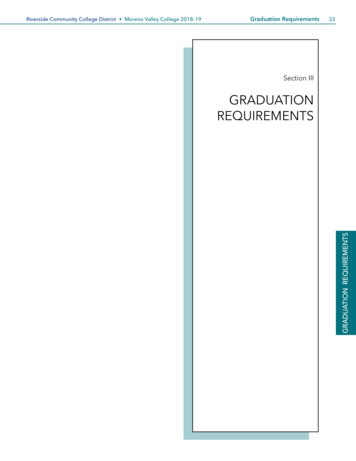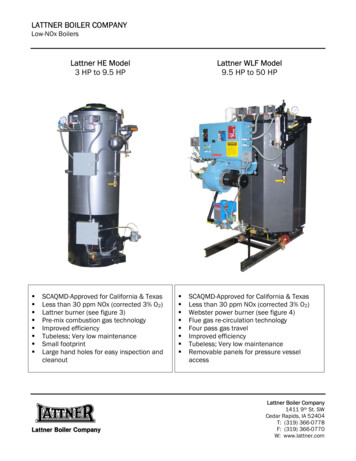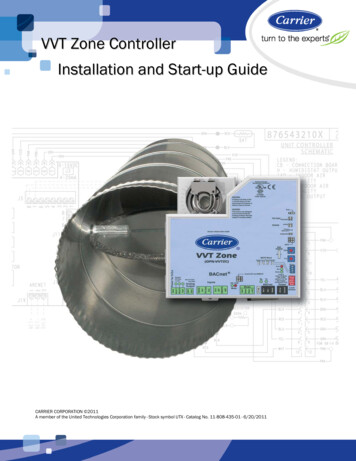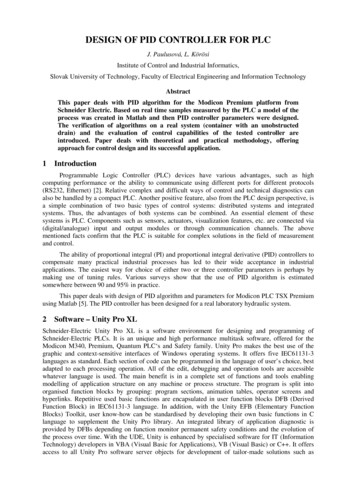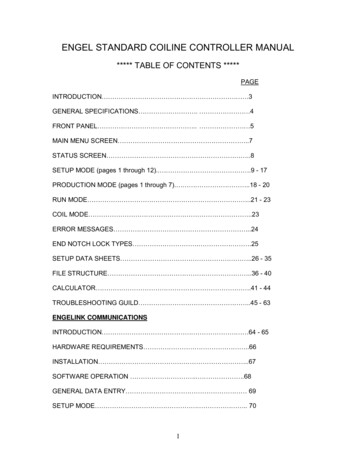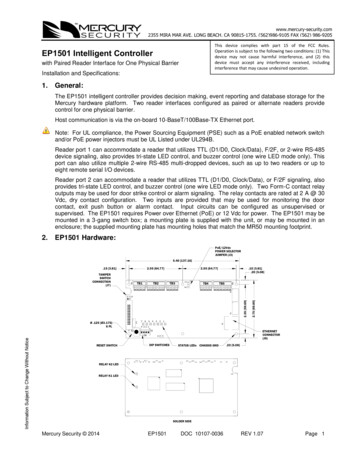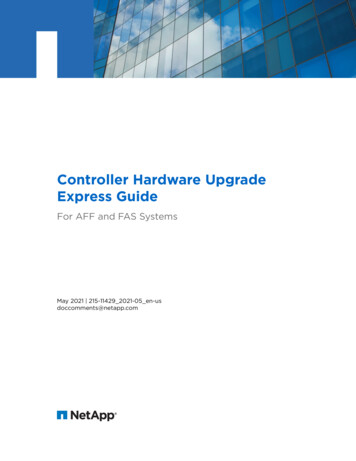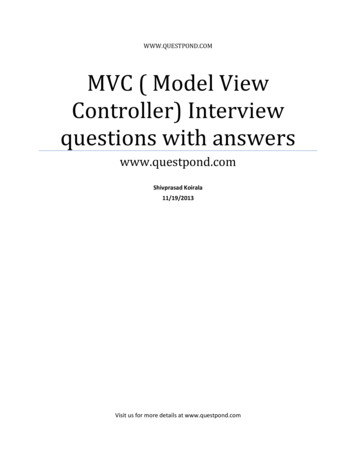
Transcription
WWW.QUESTPOND.COMMVC ( Model ViewController) Interviewquestions with answerswww.questpond.comShivprasad Koirala11/19/2013Visit us for more details at www.questpond.com
MVC Interview questions and answersWhat is MVC?. 2Can you explain the complete flow of MVC? . 2Is MVC suitable for both windows and web application? . 2What are the benefits of using MVC? . 2Is MVC different from a 3 layered architecture? . 3What is the latest version of MVC? . 4What is the difference between each version of MVC? . 4What are routing in MVC? . 4Where is the route mapping code written? . 4Can we map multiple URL’s to the same action? . 5How can we navigate from one view to other view using hyperlink? . 5How can we restrict MVC actions to be invoked only by GET or POST? . 5How can we maintain session in MVC? . 5What is the difference between tempdata , viewdata and viewbag? . 5What are partial views in MVC? . 7How did you create partial view and consume the same? . 7How can we do validations in MVC? . 8Can we display all errors in one go? . 10What are the other data annotation attributes for validation in MVC? . 10How can we enable data annotation validation on client side? . 11What is razor in MVC? . 11Why razor when we already had ASPX? . 11So which is a better fit Razor or ASPX? . 12How can you do authentication and authorization in MVC? . 12How to implement windows authentication for MVC? . 12How do you implement forms authentication in MVC? . 12How to implement Ajax in MVC? . 13What kind of events can be tracked in AJAX ? . 16What is the difference between “ActionResult” and “ViewResult”? . 16What are the different types of results in MVC?. 16What are “ActionFilters”in MVC? . 17Can we create our custom view engine using MVC? . 19How to send result back in JSON format in MVC? . 22What is “WebAPI”? . 23But WCF SOAP also does the same thing, so how does “WebAPI” differ? . 23With WCF also you can implement REST,So why "WebAPI"? . 23How to implement “WebAPI” in MVC? . 23How can we detect that a MVC controller is called by POST or GET ? . 25What is Bundling and minification in MVC? . 26How does bundling increase performance?. 26So how do we implement bundling in MVC ? . 27How can you test bundling in debug mode ? . 28Explain minification and how to implement the same ? . 28How to implement minification ?. 29What is the use of “AllowHTML” and “ValidateInput” attributes? . 29
What is MVC?MVC is an architectural pattern which separates the representation and the user interaction. It’s divided into three broader sections, “Model”, “View” and “Controller”. Below is how each one of them handles thetask. The “View” is responsible for look and feel. “Model” represents the real world object and provides data to the “View”. The “Controller” is responsible to take the end user request and load the appropriate “Model” and“View”.MVC (Model view controller)Can you explain the complete flow of MVC?Below are the steps how control flows in MVC (Model, view and controller) architecture: All end user requests are first sent to the controller. The controller depending on the request decides which model to load. The controller loads themodel and attaches the model with the appropriate view. The final view is then attached with the model data and sent as a response to the end user on thebrowser.Is MVC suitable for both windows and web application?MVC architecture is suited for web application than windows. For window application MVP i.e. “Modelview presenter” is more duetobindings.What are the benefits of using MVC?There are two big benefits of MVC:-
Separation of concerns is achieved as we are moving the code behind to a separate class file. Bymoving the binding code to a separate class file we can reuse the code to a great extent. Automated UI testing is possible because now the behind code (UI interaction code) has moved toa simple.NET class. This gives us opportunity to write unit tests and automate manual testing.Is MVC different from a 3 layered architecture?MVC is an evolution of a 3 layered traditional architecture. Many components of 3 layered architectureare part of MVC. So below is how the mapping goes.Functionality3 layered / tiered architectureModel view controller architectureLook and FeelUser interface.View.UI logicUser interface.ControllerBusiness logic /validationsMiddle layerModel.Request is first sent toUser interfaceController.Accessing dataData access layer.Data access layer.Figure 6.2:- 3 layered architecture
What is the latest version of MVC?When this note was written, four versions where released of MVC. MVC 1 , MVC 2, MVC 3 and MVC4. So the latest is MVC 4.What is the difference between each version of MVC?Below is a detail table of differences. But during interview it’s difficult to talk about all of them due totime limitation. So I have highlighted important differences which you can run through before theinterviewer.MVC 2Client-Side ValidationTemplated HelpersAreasAsynchronous ControllersHtml.ValidationSummary Helper MethodDefaultValueAttribute in Action-MethodParametersBinding Binary Data with Model BindersDataAnnotations AttributesModel-Validator ProvidersNew RequireHttpsAttribute Action FilterTemplated HelpersDisplay Model-Level ErrorsMVC 3RazorReadymade projecttemplatesHTML 5 enabled templatesSupport for Multiple ViewEnginesJavaScript and AjaxModel ValidationImprovementsMVC 4ASP.NET Web APIRefreshed and modernized defaultproject templatesNew mobile project templateMany new features to supportmobile appsEnhanced support forasynchronous methodsWhat are routing in MVC?Routing helps you to define a URL structure and map the URL with the controller.For instance let’s say we want that when any user types “http://localhost/View/ViewCustomer/” , it goesto the “Customer” Controller and invokes “DisplayCustomer” action. This is defined by adding an entryin to the “routes” collection using the “maproute” function. Below is the under lined code which showshow the URL structure and mapping with controller and action is defined.routes.MapRoute("View", // Route name"View/ViewCustomer/{id}", // URL with parametersnew { controller "Customer", action "DisplayCustomer", id UrlParameter.Optional }); // Parameter defaultsWhere is the route mapping code written?The route mapping code is written in the “global.asax” file.
Can we map multiple URL’s to the same action?Yes , you can , you just need to make two entries with different key names and specify the samecontroller and action.How can we navigate from one view to other view using hyperlink?By using “ActionLink” method as shown in the below code. The below code will create a simple URLwhich help to navigate to the “Home” controller and invoke the “GotoHome” action. % Html.ActionLink("Home","Gotohome") % How can we restrict MVC actions to be invoked only by GET or POST?We can decorate the MVC action by “HttpGet” or “HttpPost” attribute to restrict the type of HTTP calls.For instance you can see in the below code snippet the “DisplayCustomer” action can only be invoked by“HttpGet”. If we try to make Http post on “DisplayCustomer” it will throw an error.[HttpGet]public ViewResult DisplayCustomer(int id){Customer objCustomer Customers[id];return View("DisplayCustomer",objCustomer);}How can we maintain session in MVC?Sessions can be maintained in MVC by 3 ways tempdata ,viewdata and viewbag.What is the difference between tempdata ,viewdataandviewbag?
Figure 6.3:- difference between tempdata ,viewdata and viewbagTemp data: -Helps to maintain data when you move from one controller to other controller or from oneaction to other action. In other words when you redirect,“tempdata” helps to maintain data between thoseredirects. It internally uses session variables.View data: - Helps to maintain data when you move from controller to view.View Bag: - It’s a dynamic wrapper around view data. When you use “Viewbag” type casting is notrequired. It uses the dynamic keyword internally.Figure 6.4:-dynamic keywordSession variables: - By using session variables we can maintain data from any entity to any entity.
Hidden fields and HTML controls: - Helps to maintain data from UI to controller only. So you can senddata from HTML controls or hidden fields to the controller using POST or GET HTTP methods.Below is a summary table which shows different mechanism of persistence.Maintains data betweenViewData/ViewBagController to Controller NoTempDataHidden fieldsSessionYesNoYesController to ViewYesNoNoYesView to ControllerNoNoYesYesWhat are partial views in MVC?Partial view is a reusable view (like a user control) which can be embedded inside other view.For example let’s say all your pages of your site have a standard structure with left menu, headerand footer as shown in the image below.Figure 6.5:- partial views in MVCFor every page you would like to reuse the left menu, header and footer controls. So you can goand create partial views for each of these items and then you call that partial view in the mainview.How did you create partial view and consume the same?When you add a view to your project you need to check the “Create partial view” check box.
Figure6.6:-createpartialviewOnce the partial view is created you can then call the partial view in the main view using“Html.RenderPartial” method as shown in the below code snippet. body div % Html.RenderPartial("MyView"); % /div /body How can we do validations in MVC?One of the easy ways of doing validation in MVC is by using data annotations. Data annotations arenothing but attributes which you can be applied on the model properties. For example in the below codesnippet we have a simple “customer” class with a property “customercode”.This”CustomerCode” property is tagged with a “Required” data annotation attribute. In other words if thismodel is not provided customer code it will not accept the same.public class Customer{[Required(ErrorMessage "Customer code is required")]public string CustomerCode
{set;get;}}In order to display the validation error message we need to use “ValidateMessageFor” method whichbelongs to the “Html” helper class. % using (Html.BeginForm("PostCustomer", "Home", FormMethod.Post)){ % % Html.TextBoxFor(m m.CustomerCode)% % Html.ValidationMessageFor(m m.CustomerCode)% input type "submit" value "Submit customer data" / %}% Later in the controller we can check if t
MVC ( Model View Controller) Interview questions with answers. www.questpond.com. Shivprasad Koirala 11/19/2013. Visit us for more details at www.questpond.com. MVC Interview questions and answers. What is MVC?. 2 Can .
